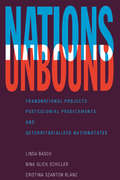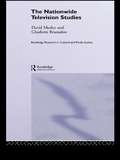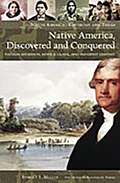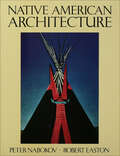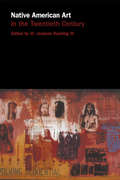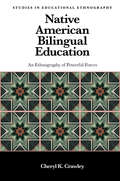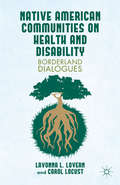- Table View
- List View
Nations Unbound: Transnational Projects, Postcolonial Predicaments and Deterritorialized Nation-States
by Linda Basch Nina Glick Schiller Cristina Szanton BlancNations Unbound is a pioneering study of an increasing trend in migration-transnationalism. Immigrants are no longer rooted in one location. By building transnational social networks, economic alliances and political ideologies, they are able to cross the geographic and cultural boundaries of both their countries of origin and of settlement. Through ethnographic studies of immigrant populations, the authors demonstrate that transnationalism is something other than expanded nationalism. By placing immigrants in a limbo between settler and visitor, transnationalism challenges the concepts of citizenship and of nationhood itself.
Nations Unbound: Transnational Projects, Postcolonial Predicaments and Deterritorialized Nation-States
by Linda Basch Nina Glick Schiller Cristina Szanton BlancNations Unbound is a pioneering study of an increasing trend in migration-transnationalism. Immigrants are no longer rooted in one location. By building transnational social networks, economic alliances and political ideologies, they are able to cross the geographic and cultural boundaries of both their countries of origin and of settlement. Through ethnographic studies of immigrant populations, the authors demonstrate that transnationalism is something other than expanded nationalism. By placing immigrants in a limbo between settler and visitor, transnationalism challenges the concepts of citizenship and of nationhood itself.
Nations Unbound: Transnational Projects, Postcolonial Predicaments, and Deterritorialized Nation-States
by Linda Basch Nina Glick Schiller Christina Szanton BlancNations Unbound is a pioneering study of an increasing trend in migration-transnationalism. Immigrants are no longer rooted in one location. By building transnational social networks, economic alliances and political ideologies, they are able to cross the geographic and cultural boundaries of both their countries of origin and of settlement. Through ethnographic studies of immigrant populations, the authors demonstrate that transnationalism is something other than expanded nationalism. By placing immigrants in a limbo between settler and visitor, transnationalism challenges the concepts of citizenship and of nationhood itself.
Nations Unbound: Transnational Projects, Postcolonial Predicaments, and Deterritorialized Nation-States
by Linda Basch Nina Glick Schiller Cristina Szanton BlancNations Unbound is a pioneering study of an increasing trend in migration-transnationalism. Immigrants are no longer rooted in one location. By building transnational social networks, economic alliances and political ideologies, they are able to cross the geographic and cultural boundaries of both their countries of origin and of settlement. Through ethnographic studies of immigrant populations, the authors demonstrate that transnationalism is something other than expanded nationalism. By placing immigrants in a limbo between settler and visitor, transnationalism challenges the concepts of citizenship and of nationhood itself.
The Nationwide Television Studies (Routledge Research in Cultural and Media Studies)
by Charlotte Brunsdon David MorleyThis book brings together for the first time David Morley and Charlotte Brunsdon's classic texts, Everyday Television: Nationwide and The Nationwide Audience. Originally published in 1978 and 1980 these two research projects combine innovative textual readings and audience analysis of the BBC's current affairs programme Nationwide. In a specially written introduction the authors trace the history of the original Nationwide project and clarify the origins of the two books.
The Nationwide Television Studies (Routledge Research in Cultural and Media Studies)
by Charlotte Brunsdon David MorleyThis book brings together for the first time David Morley and Charlotte Brunsdon's classic texts, Everyday Television: Nationwide and The Nationwide Audience. Originally published in 1978 and 1980 these two research projects combine innovative textual readings and audience analysis of the BBC's current affairs programme Nationwide. In a specially written introduction the authors trace the history of the original Nationwide project and clarify the origins of the two books.
Native: Life in a Vanishing Landscape
by Patrick LaurieShortlisted for The Wainwright Prize for UK Nature Writing 2020'A rare breed of a book … to be greatly treasured' - Daily MailDesperate to connect with his native Galloway, Patrick Laurie plunges into work on his family farm in the hills of southwest Scotland. Investing in the oldest and most traditional breeds of Galloway cattle, he begins to discover how cows once shaped people, places and nature in this remote and half-hidden place. This traditional breed requires different methods of care from modern farming on an industrial, totally unnatural scale.As the cattle begin to dictate the pattern of his life, Patrick stumbles upon the passing of an ancient rural heritage. Always one of the most isolated and insular parts of the country, as the twentieth century progressed, the people of Galloway deserted the land and the moors have been transformed into commercial forest in the last thirty years. The people and the cattle have gone, and this withdrawal has shattered many centuries of tradition and custom. Much has been lost, and the new forests have driven the catastrophic decline of the much-loved curlew, a bird which features strongly in Galloway's consciousness. The links between people, cattle and wild birds become a central theme as Patrick begins to face the reality of life in a vanishing landscape.
Native Advertising: Advertorial Disruption in the 21st-Century News Feed (Disruptions)
by Lisa LynchNative Advertising examines the emerging practices and norms around native advertising in US and European news organizations. Over the past five years native advertising has rapidly become a significant revenue stream for both digital news “upstarts” and legacy newspapers and magazines. This book helps scholars and students of journalism and advertising to understand the news industry’s investment in native advertising, and consider the effects this investment might have on how news is produced, consumed, and understood. It is argued that although they have deep roots in earlier forms of advertising, native ads with a political or advocacy bent have the potential to shift the relationship between news outlets and audiences in new ways, particularly in an era when trust in the media has reached a historic low point. Beyond this, such advertisements have the potential to shift how media systems function in relation to state power, by changing the relationship between commercial and non-commercial speech. Drawing on real-world examples of native ads and including an in-depth case study contributed by Ava Sirrah, Native Advertising provides an important assessment of the potential consequences of native advertising becoming an even more prominent fixture in the 21st-century news feed.
Native Advertising: Advertorial Disruption in the 21st-Century News Feed (Disruptions)
by Lisa LynchNative Advertising examines the emerging practices and norms around native advertising in US and European news organizations. Over the past five years native advertising has rapidly become a significant revenue stream for both digital news “upstarts” and legacy newspapers and magazines. This book helps scholars and students of journalism and advertising to understand the news industry’s investment in native advertising, and consider the effects this investment might have on how news is produced, consumed, and understood. It is argued that although they have deep roots in earlier forms of advertising, native ads with a political or advocacy bent have the potential to shift the relationship between news outlets and audiences in new ways, particularly in an era when trust in the media has reached a historic low point. Beyond this, such advertisements have the potential to shift how media systems function in relation to state power, by changing the relationship between commercial and non-commercial speech. Drawing on real-world examples of native ads and including an in-depth case study contributed by Ava Sirrah, Native Advertising provides an important assessment of the potential consequences of native advertising becoming an even more prominent fixture in the 21st-century news feed.
Native America [3 volumes]: A State-by-State Historical Encyclopedia [3 volumes]
by Daniel S. MurphreeEmploying innovative research and unique interpretations, these essays provide a fresh perspective on Native American history by focusing on how Indians lived and helped shape each of the United States.Native America: A State-by-State Historical Encyclopedia comprises 50 chapters offering interpretations of Native American history through the lens of the states in which Indians lived or helped shape. This organizing structure and thematic focus allows readers access to information on specific Indians and the regions they lived in while also providing a collective overview of Native American relationships with the United States as a whole.These three volumes synthesize scholarship on the Native American past to provide both an academic and indigenous perspective on the subject, covering all states and the native peoples who lived in them or were instrumental to their development. Each state is featured in its own chapter, authored by a specialist on the region and its indigenous peoples. Each essay has these main sections: Chronology, Historical Overview, Notable Indians, Cultural Contributions, and Bibliography. The chapters are interspersed with photographs and illustrations that add visual clarity to the written content, put a human face on the individuals described, and depict the peoples and environment with which they interacted.
Native America [3 volumes]: A State-by-State Historical Encyclopedia [3 volumes]
Employing innovative research and unique interpretations, these essays provide a fresh perspective on Native American history by focusing on how Indians lived and helped shape each of the United States.Native America: A State-by-State Historical Encyclopedia comprises 50 chapters offering interpretations of Native American history through the lens of the states in which Indians lived or helped shape. This organizing structure and thematic focus allows readers access to information on specific Indians and the regions they lived in while also providing a collective overview of Native American relationships with the United States as a whole.These three volumes synthesize scholarship on the Native American past to provide both an academic and indigenous perspective on the subject, covering all states and the native peoples who lived in them or were instrumental to their development. Each state is featured in its own chapter, authored by a specialist on the region and its indigenous peoples. Each essay has these main sections: Chronology, Historical Overview, Notable Indians, Cultural Contributions, and Bibliography. The chapters are interspersed with photographs and illustrations that add visual clarity to the written content, put a human face on the individuals described, and depict the peoples and environment with which they interacted.
Native America, Discovered and Conquered: Thomas Jefferson, Lewis & Clark, and Manifest Destiny (Native America: Yesterday and Today)
by Robert J. MillerManifest Destiny, as a term for westward expansion, was not used until the 1840s. Its predecessor was the Doctrine of Discovery, a legal tradition by which Europeans and Americans laid legal claim to the land of the indigenous people that they discovered. In the United States, the British colonists who had recently become Americans were competing with the English, French, and Spanish for control of lands west of the Mississippi. Who would be the discoverers of the Indians and their lands, the United States or the European countries? We know the answer, of course, but in this book, Miller explains for the first time exactly how the United States achieved victory, not only on the ground, but also in the developing legal thought of the day.The American effort began with Thomas Jefferson's authorization of the Lewis & Clark Expedition, which set out in 1803 to lay claim to the West. Lewis and Clark had several charges, among them the discovery of a Northwest Passage—a land route across the continent—in order to establish an American fur trade with China. In addition, the Corps of Northwestern Discovery, as the expedition was called, cataloged new plant and animal life, and performed detailed ethnographic research on the Indians they encountered. This fascinating book lays out how that ethnographic research became the legal basis for Indian removal practices implemented decades later, explaining how the Doctrine of Discovery became part of American law, as it still is today.
Native American Adoption, Captivity, and Slavery in Changing Contexts (Studies of the Americas)
by Max Carocci & Stephanie PrattRadically rethinks the theoretical parameters through which we interpret both current and past ideas of captivity, adoption, and slavery among Native American societies in an interdisciplinary perspective. Highlights the importance of the interaction between perceptions, representations and lived experience associated with the facts of slavery.
Native American Architecture
by Peter Nabokov Robert EastonFor many people, Native American architecture calls to mind the wigwam, tipi, iglu, and pueblo. Yet the richly diverse building traditions of Native Americans encompass much more, including specific structures for sleeping, working, worshipping, meditating, playing, dancing, lounging, giving birth, decision-making, cleansing, storing and preparing food, caring for animals, and honoring the dead. In effect, the architecture covers all facets of Indian life. The collaboration between an architect and an anthropologist, Native American Architecture presents the first book-length, fully illustrated exploration of North American Indian architecture to appear in over a century. Peter Nabokov and Robert Easton together examine the building traditions of the major tribes in nine regional areas of the continent from the huge plank-house villages of the Northwest Coast to the moundbuilder towns and temples of the Southeast, to the Navajo hogans and adobe pueblos of the Southwest. Going beyond a traditional survey of buildings, the book offers a broad, clear view into the Native American world, revealing a new perspective on the interaction between their buildings and culture. Looking at Native American architecture as more than buildings, villages, and camps, Nabokov and Easton also focus on their use of space, their environment, their social mores, and their religious beliefs. Each chapter concludes with an account of traditional Indian building practices undergoing a revival or in danger today. The volume also includes a wealth of historical photographs and drawings (including sixteen pages of color illustrations), architectural renderings, and specially prepared interpretive diagrams which decode the sacred cosmology of the principal house types.
Native American Art in the Twentieth Century: Makers, Meanings, Histories
by W. Jackson Rushing IIIThis illuminating and provocative book is the first anthology devoted to Twentieth Century Native American and First Nation art. Native American Art brings together anthropologists, art historians, curators, critics and distinguished Native artists to discuss pottery, painitng, sculpture, printmaking, photography and performance art by some of the most celebrated Native American and Canadian First Nation artists of our timeThe contributors use new theoretical and critical approaches to address key issues for Native American art, including symbolism and spirituality, the role of patronage and musuem practices, the politics of art criticism and the aesthetic power of indigenous knowledge. The artist contributors, who represent several Native nations - including Cherokee, Lakota, Plains Cree, and those of the PLateau country - emphasise the importance of traditional stories, myhtologies and ceremonies in the production of comtemporary art. Within great poignancy, thye write about recent art in terms of home, homeland and aboriginal sovereigntyTracing the continued resistance of Native artists to dominant orthodoxies of the art market and art history, Native American Art in the Twentieth Century argues forcefully for Native art's place in modern art history.
Native American Art in the Twentieth Century: Makers, Meanings, Histories
by W. Jackson Rushing IIIThis illuminating and provocative book is the first anthology devoted to Twentieth Century Native American and First Nation art. Native American Art brings together anthropologists, art historians, curators, critics and distinguished Native artists to discuss pottery, painitng, sculpture, printmaking, photography and performance art by some of the most celebrated Native American and Canadian First Nation artists of our timeThe contributors use new theoretical and critical approaches to address key issues for Native American art, including symbolism and spirituality, the role of patronage and musuem practices, the politics of art criticism and the aesthetic power of indigenous knowledge. The artist contributors, who represent several Native nations - including Cherokee, Lakota, Plains Cree, and those of the PLateau country - emphasise the importance of traditional stories, myhtologies and ceremonies in the production of comtemporary art. Within great poignancy, thye write about recent art in terms of home, homeland and aboriginal sovereigntyTracing the continued resistance of Native artists to dominant orthodoxies of the art market and art history, Native American Art in the Twentieth Century argues forcefully for Native art's place in modern art history.
Native American Bilingual Education: An Ethnography of Powerful Forces (Studies in Educational Ethnography)
by Dr Cheryl K. CrawleyFor over thirty years, a political and social battle over bilingual education raged in the U.S. and in and around the Crow Indian Reservation of Montana. This book, a period piece rich in political, historical, and local western context, is the story of language, education, inequality and power clashes between the dominant society and the Indian tribe as historical events unfolded. This is a classic ethnography that documents eight years of the author’s day-to-day experience as a teacher, bilingual education coordinator, and central office administrator during the socio-political dispute. The author showcases the familial, linguistic, and ancestral place-based strengths of the Crow families that empowered children to succeed in school against the odds, providing a secure foundation for their future leadership within the tribe. In doing this, the author builds strong support for bridging Native and Euro-American philosophies within a bilingual framework. This book is important reading for teachers, administrators, and policy-makers. It provides hope, ideas, and concrete actions for those who would engage in change management to improve learning environments and better serve diverse students.
Native American Bilingual Education: An Ethnography of Powerful Forces (Studies in Educational Ethnography)
by Dr Cheryl K. CrawleyFor over thirty years, a political and social battle over bilingual education raged in the U.S. and in and around the Crow Indian Reservation of Montana. This book, a period piece rich in political, historical, and local western context, is the story of language, education, inequality and power clashes between the dominant society and the Indian tribe as historical events unfolded. This is a classic ethnography that documents eight years of the author’s day-to-day experience as a teacher, bilingual education coordinator, and central office administrator during the socio-political dispute. The author showcases the familial, linguistic, and ancestral place-based strengths of the Crow families that empowered children to succeed in school against the odds, providing a secure foundation for their future leadership within the tribe. In doing this, the author builds strong support for bridging Native and Euro-American philosophies within a bilingual framework. This book is important reading for teachers, administrators, and policy-makers. It provides hope, ideas, and concrete actions for those who would engage in change management to improve learning environments and better serve diverse students.
Native American Boarding Schools (Landmarks of the American Mosaic)
by Mary A. StoutA broadly based historical survey, this book examines Native American boarding schools in the United States from Puritan times to the present day.Hundreds of thousands of Native Americans are estimated to have attended Native American boarding schools during the course of over a century. Today, many of the off-reservation Native American boarding schools have closed, and those that remain are in danger of losing critical federal funding. Ironically, some Native Americans want to preserve them. This book provides a much-needed historical survey of Native American boarding schools that examines all of these educational institutions across the United States and presents a balanced view of many personal boarding school experiences—both positive and negative. Author Mary A. Stout, an expert in American Indian subjects, places Native American boarding schools in context with other American historical and educational movements, discussing not only individual facilities but also the specific outcomes of this educational paradigm.
Native American Boarding Schools (Landmarks of the American Mosaic)
by Mary A. StoutA broadly based historical survey, this book examines Native American boarding schools in the United States from Puritan times to the present day.Hundreds of thousands of Native Americans are estimated to have attended Native American boarding schools during the course of over a century. Today, many of the off-reservation Native American boarding schools have closed, and those that remain are in danger of losing critical federal funding. Ironically, some Native Americans want to preserve them. This book provides a much-needed historical survey of Native American boarding schools that examines all of these educational institutions across the United States and presents a balanced view of many personal boarding school experiences—both positive and negative. Author Mary A. Stout, an expert in American Indian subjects, places Native American boarding schools in context with other American historical and educational movements, discussing not only individual facilities but also the specific outcomes of this educational paradigm.
Native American Communities on Health and Disability: A Borderland Dialogues
by L. Lovern C. LocustThis volume examines concepts of disability and wellness in Native American communities, prominently featuring the life's work of Dr. Carol Locust. Authors Locust and Lovern confront the difficulties of translating not only words but also entire concepts between Western and Indigenous cultures, and by increasing the cultural competency of those unfamiliar with Native American ways of being are able to bring readers from both cultures into a more equal dialogue. The three sections contained herein focus on intercultural translation; dialogues with Native American community members; and finally a discussion of being in the world gently as caregivers.
Native American Education: A Reference Handbook (Contemporary Education Issues)
by Lorraine HaleThis authoritative volume puts the schooling of Native American children in the broader context of the country's educational agenda and demonstrates how Native American learning continues to be a challenge to minority education in the United States.This fascinating overview provides a comprehensive introduction to the education of Native Americans in the United States. Historically, schools were seen as essential to formal education but also as the custodians of community values, a way to socialize Native Americans into the European way of life.Native American Education: A Reference Handbook describes the role played by various churches and missionaries and their different approaches to education against a backdrop of mostly unfamiliar social and legal history. For example, most Americans probably do not know that Indians helped write the Constitution and that an Indian served as vice president of the United States. Author Lorraine Hale provides strategies for preserving Indian culture within the framework of modern American education.
Native American Folklore & Traditions
by Elsie Clews ParsonFrom the Mojave Desert to the arctic expanses of Baffin Island, the rituals and traditions of the First Peoples of North America blur the boundaries between myth and reality.This treasury brings together many spectacular tales from Native American folklore. Recorded from oral traditions by a variety of anthropologists, these heart-warming, magical and cautionary tales open a new window into the diversity and wonder of cultures that continue to thrive in the modern world.Learn of potlash and marriage ceremonies, harvests and hunts, and how to survive in a hostile climate. Meet wonderful characters such as White-hip the shaman, Slender-maiden of the Apache and Sayach'apis, a Nootka trader. Featuring stunning photographic portraits of First Nation peoples by Edward S. Curtis, as well as beautiful artwork by Charles Marion Russell and Frederic Remington, this illustrated volume helps bring these remarkable stories to life.
Native American Folktales (Stories from the American Mosaic)
by Thomas A. GreenFolktales are at the heart of Native American culture. Prepared especially for students and general readers, this book conveniently collects 31 of the most important Native American folktales. These are drawn from the major Native American cultural and geographical areas and are organized in sections on origins; heroes, heroines, villains, and fools; society and conflict; and the supernatural. The tales reflect the environment, cultural adaptations, and prevailing concerns of the areas from which they are taken. Each tale begins with a brief introductory headnote, and the book closes with a selected bibliography. Students in social studies classes will welcome this book as a window on Native American culture, while students in literature courses will value its exploration of Native American oral traditions.Prepared especially for students and general readers, this book conveniently collects and comments on 31 of the most important Native American folktales. These are drawn from the major Native American cultural and geographical areas and reflect the environment, cultural adaptations, and prevailing concerns of the regions from which they are taken.
Native American Issues (Contemporary American Ethnic Issues)
by Paul C. RosierThis volume presents six major issues that have been divisive in and out of the Native American community. Readers will learn about the varied cultural, political, social, and economic dimensions of contemporary Native America and will be prompted to consider the complexity and complications of ethnic and cultural diversity in the United States.Where do you stand on the issue of sports teams named after Native Americans? Are tribal claims on ancestral remains and sacred objects in museums valid? The contemporary issues that Native Americans struggle with are critical concerns for all Americans. This volume presents six major issues that have been divisive in and out of the Native American community. Readers will learn about the varied cultural, political, social, and economic dimensions of contemporary Native America and will be prompted to consider the complexity and complications of ethnic and cultural diversity in the United States.Readers will ponder the very foundations of the United States and the rights of its original inhabitants' descendants. The range of issues encompasses Native Americans throughout the country, from the Mashpee Wampanoags of Massachusetts to Pacific Northwest tribes. This book incorporates views from a wide variety of sources, including newspaper op-eds, Supreme Court rulings, and more. A resource guide complementing each chapter includes an extensive listing of suggested reading plus videos/film, Web sites, and organizations.
